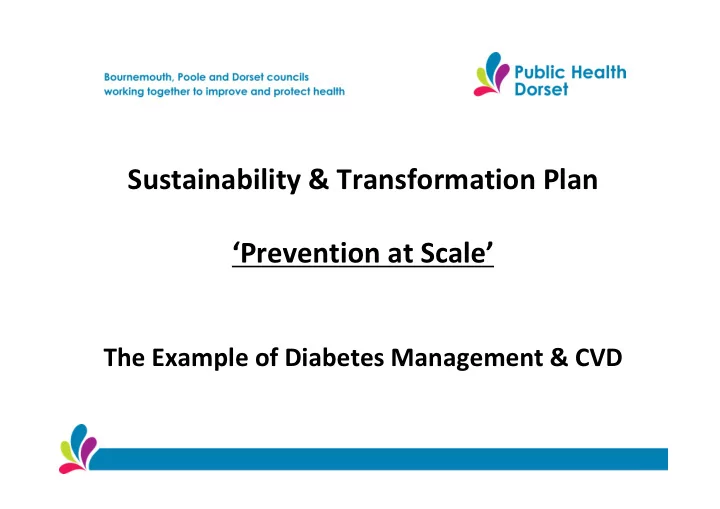

Sustainability & Transformation Plan ‘Prevention at Scale’ The Example of Diabetes Management & CVD
Purpose of this presentation • Describe the context for closing the H&WB gap and rationale for Prevention at Scale within the STP • Illustrate the challenge in Dorset in regard to one of our agreed priorities i.e. Diabetes and CVD. • Describe some ideas about moving forward
Introduction Why are we discussing Prevention at Scale? • Because a sustained approach to prevention is one of a limited number of options that may reduce the burden of disease, demand and service costs in an ageing population. What does it mean? • We don’t know - only really good examples are mass vaccination campaigns in response to national/global epidemics and sanitation infrastructure! Challenges : • Language : the word means differing things to differing people – often not recognised or reconciled. • Individual behavior change: difficult, often needs legislation e.g. seat belts, but seen as an intrusion on personal liberty etc, we know little about behaviour change in a social media world. • Prevention Paradox: Lots of people not at ‘risk’ have to change a little to benefit the population a lot!
Prevention at Scale – Themes and Approaches 1. Three themes – ‘outcomes’ we wish to prevent/improve • Diabetes & Cardiovascular Disease: Why ? High levels of early death and disease, High levels of health and care utilisation. High investment. • Alcohol : Why ? Diverse societal outcomes across multiple agencies with high societal costs. Medium investment. • Mental Health/Musculoskeletal Disease : Why? Highest global causes of loss of quality of life: large numbers of the population affected by long standing reduction in quality of life; high levels of productivity loss to society and local employers; low investment. 2. Three approaches: Individual + Organisational + Place based
PAS as part of the STP The STP describes three programmes PAS, ICS & acute network. In practice these will have important areas of commonality both of content and approach As such that they might better be represented as below rather than discrete parts of one triangle as per STP document
The natural history of diabetes and CVD.
Outcomes for CVD: How do we explain these changes? A UK perspective: 1981-2000 Risk Factors worse +13% 0 Obesity (increase) + 3 .5 % Diabetes (increase) + 5 % Physical activity (less) + 4 .5 % Risk Factors better - -20000 71% Smoking -41% Cholesterol -9% -40000 Population BP fall -9% Deprivation -3% Other factors -8% 68,230 Treatments -42% -60000 Heart attack -8% fewer deaths Secondary prevention -11% Heart failure -12% Angina:CABG & PTCA -4% -80000 Angina: Aspirin etc -5% Hypertension therapies -3% 1981 Unal, Critchley & Capewell Circulation 2004 109(9) 2000 1101-7
Local Changes: Early deaths from CVD since 2003 Changes in rates year on year
Explaining local changes?
Explaining Local Changes? 2. Local differences in the management of people with risks CHD Diabetes CHD Diabetes Diabetes Blood pressure Cholesterol Blood sugar
Explaining Local Changes? 3. Non individual factors – Poverty & Deprivation Deaths from CVD (U75, per 100,000) Alderney Lilliput Southbourne Ferndown Wyke Regis Boscombe Least deprived… …most deprived
Explaining Local Changes? 3. Non individual factors – Poverty & Deprivation II Deaths from CVD (U75, per 100,000)
Explaining Local Changes? 3. Non individual factors – Poverty & Deprivation III % Not managed
Where should we focus? 1. Modifying Risks £s returned for every £1 invested
Where should we focus? 2. Better managing existing conditions Better Blood pressure control in people with hypertension In the next 5 years if every practice performed as top 25% Costs saved: Events avoided: NHS Social Care Stroke 69 £755,200 £273,600 Heart attack 46 £401,400 Heart failure 97 £133,700 Deaths 37 Total = £1.6m
Finally: Do we know what we don’t know? Undiagnosed Expected number Number on in Dorset GP registers cases = - - = - =
Summary The scale of the challenge is huge and given how common the risk factors for CVD • are, how many remain undiagnosed, and how many new ones arise every day it makes no sense focussing on routinely finding new cases in the general population. In terms of return on investment for population risks the best choice is promoting • physical activity & reducing overweight in the whole population. We need effective broad based efforts for weight reduction/physical activity e.g • • Individual : social /community movements - park run/pokemon go, • Place based: regeneration and green space e.g Boscombe, Melcombe regis • Organisation: 50% of NHS/LA staff , 5KM walk, 50% of days of the week Intervening as early as possible is clearly best + a focus on times of important transition • in life e.g. obesity, diabetes and smoking in pregnancy.
Summary - II • Clinical practice: the clear winner is better managing high blood pressure – but, variations, wherever they are measured, are a ‘failure’ of the whole system and not just one part. • We all need to take responsibility for shifting the curve, 10% for people with hypertension in whatever setting with will make a real difference. We also need to invest more where the problem begins not ends. • We need such approaches to be central to any new models of care and partnerships – e.g. Accountable Care. • We need to move beyond an organisational mindset of ‘what’s in it for me’ to the system default position being ‘of course we can’ - beyond QoF points or PbR medals to sharing data in real time and making common consistent decisions on care. The alternative is the perfect storm…….. . •
Recommend
More recommend